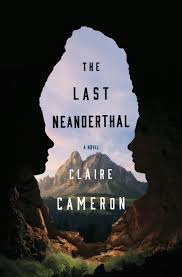On Human Brutality: A Review of Claire Cameron’s The Last Neanderthal

In 2010, scientists revealed that Neanderthals and Homo Sapiens had mated with each other, and that most of us have some Neanderthal DNA. It was unclear how this mating had taken place—whether modern humans had dashed from one community to the next, mating with all eligible creatures and then moving on, or whether the two species had spent significant time with each other.
Claire Cameron’s new novel The Last Neanderthal (Doubleday Canada) was explicitly written in response to these findings. Cameron’s novel imagines a sweet family of Neanderthals—Big Mother, Him, Girl, Bent and an adoptee called Runt—with the narrative focused around Girl. The family prizes female strength, wears symbolic jewelry, makes fire, preserves food, cares for one another, and tells stories using shadow puppets. Every few chapters, the perspective switches from the family to that of Rosamund Gale, a pregnant, present-day paleoarchaeologist on the verge of a major discovery. While both Rose and Girl experience pregnancy and the terror of being alone, Girl’s worries are immediate and life-threatening, while Rose’s concern her ego more than her survival. This setup proves intriguing and effective—Neanderthals turn out to be more sophisticated than we think, and modern women wilder and more primal.
Cameron, whose previous bestseller The Bear imagines a deadly bear attack from the perspective of a young child, continues to dwell at length on the natural world in The Last Neanderthal. Cameron’s vivid prose invites the reader to share her fascination. On fish: “As they flung their bodies up rocky steps, some were smashed on the rocks, some found themselves in the waiting reed nets of the family, and some fell into the jaws of bears… Each was as long as an arm and as thick and muscled as a thigh.” On a hungry baby bison: “As she climbed up through the mud, it clung to her hocks. The bones of her ribs hung over a knobbed spine, the imprint of the hard winter clear on her body. The calf pushed into his place close behind his mother, a nose to her tail.” Cameron transcends static descriptions of landscape, charging every detail with excitement and meaning—every scratch on birchbark signifies.
The dramas of Neanderthal life are likewise enthralling, the stakes intrinsically high. Will they have enough to eat? Will they lose too many of their numbers? Now that the evidence of first ovulation has come by smell and slime out of Girl, will she be ready for the changes required of her?
Forty thousand years later, Rose’s dramas include a desire to prioritize her career over her growing pregnancy, the choices that alienate her from her partner, a competition with a Jane Goodall-type for credit and control over the narrative of her research, a trip to IKEA—and none of these are as lively as the stories of the distant past. The Last Neanderthal struggles to find equivalent tension in its present-day story arc. Even readers who generally prefer the dangers of conversation over the dangers of the wild will find themselves impatient to return to prehistory.
Moreover, while Cameron has clearly consulted experts and many major new books discussing Neanderthals, the incorporation of this research into the narrative often feels strained, detracting from the immediacy of the storytelling. The prehistoric passages are written in the third person—closely Girl’s, sometimes slipping into the perspective of the other Neanderthals—but the narrator perceives everything with the cool tone of a present-day scientist. When Girl warms her brother’s hands with her breath, the narrator explains: “She… huffed a breath of air on his skin. This didn’t have much practical application—in a cold climate, his skin could be warmed effectively only by bringing his core temperature up—but her hot breath did wonders for his mind.” The Neanderthals, who have almost no language and rarely use more than one word at a time, obviously don’t think in terms of “core temperature”; the narration brings to mind the voiceover of a nature documentary, but is neither ironic nor consistently omniscient. While there is an exquisite understanding of science in this novel, there is less inquiry into human consciousness and its defining idiosyncrasies. Girl seems to understand her instincts as instincts, and the Neanderthals have no magic, no mysticism, no irrationality.
It’s possible the narrator is meant to be a modern-day observer who knows the Neanderthals intimately; perhaps it is Rosamund Gale herself, the paleoarcheologist. Though her passages are written in first-person, Rose regards her own life with the scientific detachment of the Neanderthals’ narrator. Near the end of her pregnancy, she muses, “My body was getting ready for the challenge of pushing out an infant with a big skull.” In both time periods, the storytelling and the research fit together awkwardly.
Still, The Last Neanderthal is absorbing, and in the end displays an instructive optimism: Cameron’s empathy for these Neanderthals provides a vision for a way of life less brutal than our own. Despite our millennia of religion, technology, and science, we’re crippled by shame and fear in a way that Cameron’s Neanderthals are not. The Last Neanderthal begins and ends by noting “their similarities to us,” and by imagining what it might feel like to be the last of your kind, the novel reflects our apocalyptic temper. But similarities are still overshadowed by differences—while Homo Sapiens have been defined by fast and constant progress, Girl has no interest in innovating: “The things she believed felt as essential as the blood that flowed through her veins. There was stillness to her culture. There were few points of contact between families. Changes rarely had a chance to spread.” Cameron has ultimately written a compassionate extinction narrative, a counter to a cold social Darwinism where only the fittest survive. Fitness is only relative to situation, not absolute. Human sophistication is human brutality.





